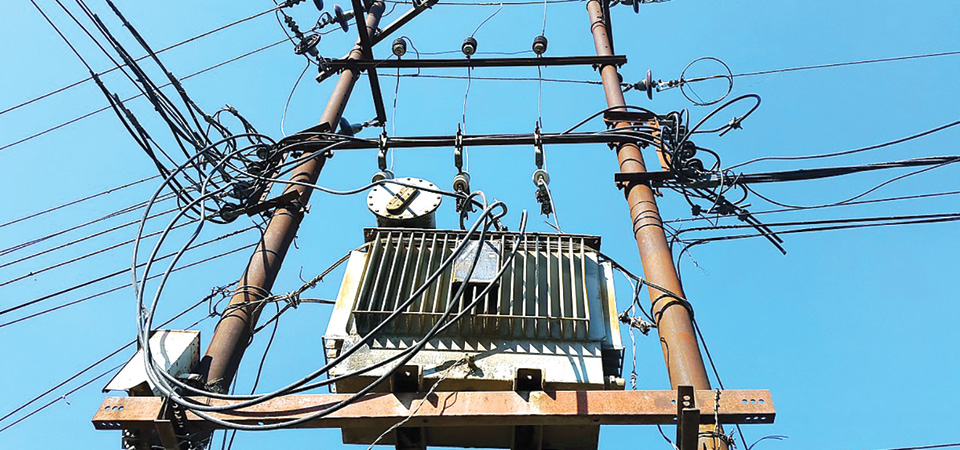Six years on, dedicated feeder row continues

By Modnath Dhakal
Kathmandu, Sept. 8: Nepal Yarn Manufacturers’ Association (NYMA) claimed that the industries do not have any electricity charge dues for the use of dedicated feeders or trunk lines as insisted by the Nepal Electricity Authority (NEA) for the past five-and-a-half years.
They also lamented that the power authority defamed the large industries which have been contributing to creation of jobs and growth of the economy.
Saying that the NEA had failed to prove that the large industries had consumed electricity against its directives, the businessmen said that they paid the dues within the deadline given by the government then.
"If the NEA presents any evidence of energy consumption through the dedicated feeder or trunk line by us, we are ready to pay the dues and even accept any legal punishment. But it should immediately stop attempts to humiliate and torture industrialists," said Pawan Kumar Golyan, President of NYMA, at a press conference organised Tuesday to talk about the dispute on the energy bills.
He said that the entrepreneurs have lost the business confidence due to the continuous pressures from the government and the NEA to pay the dues of the energy they did not use.
Another industrialist Bishnu Neupane, who is also the vice chairman of the NYMA, said that many large industries had deferred their expansion plans due to tension of electricity bills. "It was unfortunate that the court also directed us to clear the dues as proposed by the NEA," he said.
According to him, the TOD (Time of Day) metering and independent or joint study teams including experts from private sector and NEA or third party could be a solution to it.
About 300 large industrial establishments are in a fight with the state-run energy authority for more than Rs. 14 billion dues of electricity accessed through dedicated feeders and trunk lines.
The NEA had set a premium tariff with 65 per cent additional charges to the large industries using electricity through the dedicated feeders and trunk lines from 2015 August in the wake of extended power outage.
Since the country was facing load shedding of up to 16 hours a day at that time, the NEA had decided to impose high tariff to the energy intensive industries.
"But the load shedding ended in 2016. The NEA had published a notice about it in Gorkhapatra daily in 2016 January. It is an exploitation of the industries by the state," said Golyan.
Last year, the Public Accounts Committee of the House of Representatives had directed the power utility to recover the dues about Rs. 14 billion. Following it, the NEA had begun correspondence with the industries for the same. With the government waiving of the premium charge for eight-and-a-half months from Cabinet decision last year, the industries are required to pay the charges of 28 months.
But the industrialists said that they are not going to pay the 'artificial dues' created by the NEA as it had asked the industries which suffered from load shedding to settle it.
However, the NEA said that it had the statistics about the consumption of electricity by the large industries.
"The dues are regularly reviewed by the internal team of the NEA. The bills were charged as per the TOD meter. The NEA would again produce the documents if required," said Manoj Silwal, Deputy Managing Director at the NEA.
He also maintained that the authority was serious about the issue and said that fines were not imposed on the dues, rather the paid money was used to clear the earlier charges.
"The dues were finalised after a thorough investigation by a research committee. Some industries might not have used the TOD meter, that is an exception," said Silwal.
Recent News

Do not make expressions casting dout on election: EC
14 Apr, 2022
CM Bhatta says may New Year 2079 BS inspire positive thinking
14 Apr, 2022
Three new cases, 44 recoveries in 24 hours
14 Apr, 2022
689 climbers of 84 teams so far acquire permits for climbing various peaks this spring season
14 Apr, 2022
How the rising cost of living crisis is impacting Nepal
14 Apr, 2022
US military confirms an interstellar meteor collided with Earth
14 Apr, 2022
Valneva Covid vaccine approved for use in UK
14 Apr, 2022
Chair Prachanda highlights need of unity among Maoist, Communist forces
14 Apr, 2022
Ranbir Kapoor and Alia Bhatt: Bollywood toasts star couple on wedding
14 Apr, 2022
President Bhandari confers decorations (Photo Feature)
14 Apr, 2022










